Consumers have high-touch, easy-to-use digital experiences daily, whether it's their food delivery order or their rideshare to the airport. And when it comes to their financial institution (FI), they expect that same level of sophistication. Unfortunately, most FIs don’t have the right technological infrastructure to meet these needs.
This was just one takeaway from a recent webinar with FinTech Masala and Bankable FinTech, Getting it Right with BaaS: How FIs can invest in the right partners to meet customer demands for embedded finance. Executives from BillGO and Maxwell had the opportunity to discuss how FIs can set up successful partnerships with fintech companies to stay in step with consumers.
Betsy Z. Cohen, Chairman, FinTech Masala, founder of Bancorp, recalls the emergence of banking as a service (BaaS). “In the early part of the Bancorp, you really needed to understand why these fintechs and non-bank fintechs were out there and to whom they were speaking.”
“The technology reached a point where it was able to be integrated, so it wasn’t a choppy experience where you had to go to look for only a mortgage or only look for bill pay, or only look for a car loan. Instead, consumers could flow those services through their financial institution.” Which, she points out, is a great opportunity for FIs to engage more with their consumers.”
This ideal was always the goal, she said, but never became the reality.
Ken Salazar, BillGO CRO and Jon Paasonen, Co-Founder & CEO, Maxwell were featured on the webinar, which examined how financial institutions (FIs) can set up successful partnerships with fintechs and deliver more personalized experiences. Daniel Cohen, Chairman, Cohen and Company and Managing Partner of FinTech Masala served as moderator.
Fragmentation in Personal Finance
“The mortgage industry is renormalizing, and a lot of banks and credit unions are rethinking their structure. I think they also realize that mortgage is not a center of excellence for them in terms of executing, but your ability to execute on that delivered to the secondary market quickly, so you can compete with the Rocket Mortgages of the world is not something you can do on your own.”
“Mortgage is one of those key services that people get, and there is no reason why your primary FI shouldn’t get that,” adds Daniel Cohen.
Another critical service for consumers is bill pay. “Today's consumer is frustrated with the fragmentation of what it takes to manage their personal financial lives and well-being. So we’re working with the FIs and fintechs to help engage customers and bring them back, but also keep their customers from leaving,” says Salazar.
He reminds the group that most consumers are managing and paying their bills directly with the biller, which on average is 12 bills per month. Meanwhile, more than half of Americans live paycheck to paycheck and don’t have their bills on autopay.
“They are literally managing their cash flow on a daily basis, and then prioritizing when bills need to be paid, and then how they're going to pay those. And, you know, frankly, the FIs just have not updated that experience and made it easy for the consumer to manage and pay their bills.”
Daniel Cohen agreed. “We can deliver a much better in-class service. The fintechs going after bank customers are going to have full access to all these products.” The banks also need to have access, he adds.
Prioritizing Compliance
Daniel Cohen poses the question of working with regulators and how to safely integrate these types of products into FIs existing tech stacks.
Dan Long, Head of VC, FinTech Masala, says for investors like himself, what they look for goes beyond cutting-edge technology. “It’s not just about great technology — that’s really just table stakes. It’s knowing how to sell it to their customers.”
All parties agreed there is a lot of legacy bank tech that you can’t just rip out on day one.
“Both BillGO Maxwell built a wrapper around the core banking tech stack that was integrated and then also, in a modular fashion, allows those FIs to shift to a more modern tech stack,” said Long.
Betsy Cohen agrees. “Both BillGO and Maxwell provide the support to the financial institution...once the ease of integration is completed it provides the underpinnings for reporting to the regulators. One of the things those smaller institutions always struggle with is finding and funding the creation of reports that are sufficient to satisfy the regulators. That problem has been taken off the table for them by Maxwell and BillGO.
It’s an important point. FIs are professional risk managers, but many, says Salazar are starting to see the need to take action and meet their customers where they are.
That’s why, he adds, “We must be bank grade plus when it comes to compliance and regulation because we are held to an even higher standard than our FI partners. We have to make sure that we are very thorough in how we're adhering to the standards and the measures that are out there.”

The Shift to Digital
Paasonen calls out another time when banks were hesitant to change. When banks were transitioning from non-ATM to ATM — there was worry if you didn’t get consumers in the branch in front of a teller, you would never be able to build a relationship with them.
“Banks were afraid of losing touch with their customers. But in fact, what it did was create another touchpoint, where they could have another experience and engage that consumer.”
Today, consumers would rather be on a mobile site with full access to all the services they need from the comfort of their homes. Now, the challenge in front of FIs is integrating new services into the existing tech stacks in banks.
Think about the best digital experiences out there, says Salazar. “This is how consumers are looking at the partners and vendors that we work with. And that's the expectation that we get an equal, on par, or better, wow experience from those partners and vendors. And so now we are finally seeing the FIs take action.”
To that end, Betsy Cohen adds, “We’re at a point now, both in consumer awareness and technology in support, where the banks can actually take back the customer.”
Watch the Full Webinar
In case you missed it or want to revisit the conversation, you can access the full webinar replay here.


